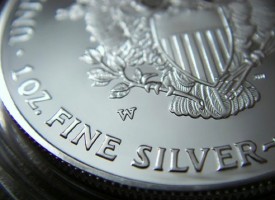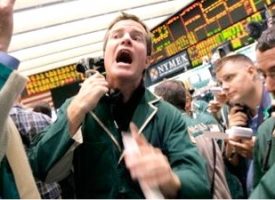With continued uncertainty in key global markets, a top analyst says that the price of gold is now set to soar to 71% within 2 years!

“By failing to prepare, you prepare to fail” — Benjamin Franklin
By Ronald-Peter Stoeferle, Incrementum AG Liechtenstein
August 10 (King World News)
The Price Of Gold Is Set To Soar!
The relationship between economists and the economy is in many ways reminiscent of that between physicians and their patients. Many economists make diagnoses about the economy’s state of health and recommend courses of action; economists responsible for (monetary) policy are implementing a substantial part of the treatment. With respect to this self-image, German top economist Hans-Werner Sinn gets to the heart of the matter by noting: “Economists warn of dangers which others are not yet aware of. After all, one also expects a physician to advise one of potential dangers after a blood test. Both in medicine and in economic science, ringing the alarm is in the nature of the job.”
The economy and the human body do indeed have something important in common: Both are complex adaptive systems imbued with the relevant properties. However, while there is a broad empirical basis for medications prescribed by physicians, which provides information about the side effects that have to be expected under certain conditions, economists rely on a far thinner empirical foundation. Monetary policymakers would therefore be well advised to abide by the ethical principle of medicine attributed to Hippocrates: “Primum non nocere, secundum cavere, tertium sanare” – before prescribing a treatment, a physician should primarily see to it that the patient isn’t harmed, and moreover carefully investigate what actually ails him. Rushed, naïve interventionism can do more damage than refraining from interference (“iatrogenic damage”).
While this insight has only slowly found acceptance in medicine, it hasn’t even appeared on the scene yet in other areas – such as in economics. Take monetary policymakers as an example, a common feature is their pronounced lack of sensitivity with respect to harmful side effects brought about by its policies. Loose monetary policy was already the root cause of the unsustainable boom of the 2000s. The crisis that inevitably came as a result was met with even more radical interventions; such as various forms of quantitative easing programs, zero and negative interest rate policies and so forth, all which have hampered the economy’s self-healing powers and have made the system dependent on continual injections of credit. As a matter of fact, every recession of the recent past has been met with ever bolder policy actions. No wonder structural imbalances have grown ever larger and more destructive. It has simply become too risky not to intervene anymore as decades of imbalances unraveling would end the system as we know it. In the meantime, populism is rising and risks are increasing. Suppressing risk has the paradoxical effect of actually increasing it…
IMPORTANT:
To find out which high-grade silver mining company billionaire Eric Sprott just purchased
a nearly 20% stake in and learn why he believes this is one of the most
exciting silver stories in the world – CLICK HERE OR BELOW:
Phenomena like asset price inflation, chronic over-indebtedness and ever more extreme boom-bust cycles, which can be attributed to the fragile interaction between inflation and deflation, are becoming more frequent. All these phenomena are symptoms of a problem with a systemic root cause. In our opinion, the centrally planned monetary system in its current state is a case for palliative care.
Below we want to summarize what this means specifically for gold and its future trend:
1. Growing uncertainty regarding economic and political developments is boosting the gold price
The current environment is unprecedented in history, characterized by a cluster of never before seen extremes:
► Debt levels continue to grow relentlessly and have by now reached dizzying heights
► Political tensions are increasing, the euro zone is ailing, there seems to be no end to the refugee crisis, Islamist terrorism is expanding globally, and on top of everything, the Brexit has become reality as well (with likely spillover effects to secessionists and nationalists across the continent)
► The global economy exhibits only modest growth and could be set to slow even further in light of the uncertainties attending the Brexit
► This weakening of economic momentum occurs in the wake of what has undoubtedly been the greatest global monetary stimulus orgy in history
► Central bank balance sheets and the money supply have grown at a pace previously only seen ahead of periods of pronounced inflation or even hyperinflation
► Since the bankruptcy of Lehman Brothers, 654 interest rate cuts have been implemented worldwide and central banks have purchased assets in the amount of USD 12.3 trillion (each central bank that attempted to raise rates in the recovery period was later forced to backtrack and rates usually ended up much lower than the level from which they started the tightening cycle)
In this unprecedented situation, risk mitigation strategies based on historical data can easily fail. Investment portfolios should be analyzed with respect to their susceptibility to possible stress scenarios, with their fragility or anti-fragility serving as an analytical compass. For example, supposedly safe government bonds, which can no longer provide any appreciable positive returns in the foreseeable future, appear potentially quite vulnerable in light of the debt trap. It is held that while stock markets may be more volatile, they at least remain in a long-term upward trend. There have nevertheless been decades-long periods during which this popular asset class hasn’t gone anywhere in nominal terms, while generating large losses in real terms (this happened e.g. in US stocks between 1966 – 1982 against the backdrop of a weak, stagflationary economy). In view of the artificial nature of the current extremely high level of stock prices, we are very skeptical regarding lures such as “dividends can replace interest income”.
“Savers can not only deposit their money in savings accounts, but have other opportunities as well”, Mario Draghi recently opined (as cynical as that may sound).126 We have presented Harry Browne’s Permanent Portfolio in this report, a historically robust investment strategy which can help one to escape from this dilemma.

2. Brexit: More economic and monetary stimulus programs to counter the disintegration of the EU should be expected
The consequences of the Brexit are not foreseeable yet as we do not know what kind of deal the UK will secure with the EU. Could the UK, or England, become a Hong Kong of Europe? Or will they be an isolated and insignificant rock in the Atlantic Ocean? It is thus obvious that these consequences will be highly dependent on the course of action the various parties to the process decide to take, and how the negotiations are conducted. The EU will in all likelihood have to deal with other member countries pondering an exit, particularly if the Brexit turns out to be favorable for the UK. It will be decisive whether EU policymakers continue their policy of intensifying European integration, centralization and bureaucratization, or if they see the Brexit as a warning shot and opt to reconsider power-sharing between the EU and national parliaments.
It appears highly likely that a lot of pressure will emanate from southern EU member states, where a lot of resentment is simmering due to the imposition of “German austerity dictates”. A strong performance of anti-austerity parties in Portugal, Italy and recently Spain substantiates this view. A further loosening of monetary policy, as well as fiscal injections – e.g. in the form of infrastructure programs via the European Investment Bank (EIB) or in the form of helicopter money (“QE for the people”) – could definitely be in the offing.
3. The US economy is softening, the planned normalization of the Fed’s interest rate policy is about to fail; an economic worldview is crumbling
The US plays an important symbolic role in the post-Lehman economy. The Fed has been most determined in the implementation of extreme monetary policy measures in the wake of the financial crisis and has been able to boost consumption and economic output again – not least by creating yet another asset price bubble. Lukewarm growth has been talked up sufficiently to create a widespread narrative of a US recovery, which has been achieved by applying (Neo-)Keynesian economic policy.
The Fed is now in the process of cautiously pioneering monetary policy normalization by exiting from its monetary emergency programs. Interest rates are to be slowly raised to normal levels again – and after much ado, a first gentle, but highly symbolic rate hike was finally implemented in December 2015.

Confidence in the recovery of the US economy and the (expected) tightening of monetary policy have led to a strengthening of the US dollar in recent years. This has weighed on commodity prices, as well as on the price of gold. The US precedent moreover appeared to confirm the curative properties of Keynesian economic policy, which has put pressure on the gold price as well. A failure of the planned normalization of US interest rates could therefore collapse the laboriously built up narrative of the economic recovery. This would increase uncertainty enormously, as faith in the salutary powers of the administrators of the monetary system is firmly tied to this narrative.
4. If the dollar weakens further and commodity prices continue to increase, rising price inflation and stagflation threaten
Ceteris paribus, the dollar tends to weaken once a rate hike cycle ends. The weakening of the euro in the wake of the Brexit is now raising a question mark with respect to this tendency. However, the fact remains that in the medium term neither the US economy, nor China, which is tied to trends in the dollar through the renminbi’s “crawling peg”, are able to tolerate a strong dollar.
Consumer price inflation could moreover easily come to life in the face of falling confidence in the currency and rising commodity prices. In combination with faltering growth, the economy could even head toward stagflation.
5. Gold investment on the part of institutional investors is about to experience a renaissance in the uncertain low interest rate environment
Central banks are skating on ever thinner ice; they are effectively stuck in a lose-lose situation:
► Continuing low interest rate policies is distorting the economy structurally, drives pension funds and insurers to the brink of ruin and boosts asset price bubbles further;
► Discontinuing the low interest rate policy risks a credit contraction, resp. a recession
In altogether five currency areas, monetary stimulus has in the meantime been carried to an extreme, by the attempt to create even more stimulus through the imposition of negative interest rates. In order to create additional leeway for this particular policy, ideas such as a cash ban have become topics of serious debate. The prospect that negative interest rate policy will succeed is negligible though. Clearly negative rates make it easier to service outstanding debt, but they also make structural economic problems even worse. Neither economic growth, nor rising consumer price inflation should be expected as a result. Gold will however benefit from the shrinking universe of attractive investment alternatives.
6. The economic environment is not only positive for gold, but also other inflation-sensitive assets, such as silver or mining stocks
The monetary system is like a fragile house of cards without vibration isolation, standing on the shifting tectonic plates of inflation and deflation. Chronic indebtedness and systemic dependence on cheap money force central banks to build an ever larger house of cards on top of the shaky foundation of last interventions (inflation imperative). This steadily increases the fragility – and this fact is slowly beginning to be appreciated by market participants.
This environment is generally not only positive for gold, but also for the prospects of other inflation-sensitive assets. The mining industry has gone through a corrective crisis, from which the remaining companies have emerged leaner and stronger. In the course of this market adjustment new priorities have been set, and companies have made a commitment to focus on profitability, capital discipline and shareholder value. Now the industry has to deliver on these promises in order to regain the trust of investors. The impressive rally in the first several months of 2016 has already hinted at the possibilities – and mining stocks still appear to be quite undervalued. After the sector’s restructuring, it is very likely that mining stocks will once again exhibit attractive gold price leverage.
7. Gold is back, a new bull market is coming into view
Gold has delivered the strongest quarterly performance in 30 years in the first quarter of 2016. Many technical indicators and sentiment gauges suggest that gold has gone through a classical cycle, which reached its low point last year amid maximum pessimism with a final wave of panic selling.
8. Incrementum confirms the long term price target of USD 2,300 by 2018
 Price Of Gold Set To Soar 71% Within 2 Years!
Price Of Gold Set To Soar 71% Within 2 Years!
Our analysis confirms the view we have already expressed in last year’s report: A significant advance in the gold price is to be expected.
Our price target of USD 2,300 for June 2018 may appear ambitious. We are firmly convinced though that systemic problems will increasingly lead to a critical reassessment of the current monetary order. In the event of such a paradigm change, a significant upward revaluation of gold seems highly probable.
Exclusive: Gerald Celente discusses more of the top trends of 2017, including what is going to shock the world in 2017 and you can listen to the incredible audio interview by CLICKING HERE OR ON THE IMAGE BELOW.
***KWN has now released the extraordinary audio interview with legendary short seller Bill Fleckenstein, where he discusses the short-term and big picture in the gold, silver, mining, and global markets, and you can access it by CLICKING HERE OR ON THE IMAGE BELOW.
 © 2016 by King World News®. All Rights Reserved. This material may not be published, broadcast, rewritten, or redistributed. However, linking directly to the articles is permitted and encouraged.
© 2016 by King World News®. All Rights Reserved. This material may not be published, broadcast, rewritten, or redistributed. However, linking directly to the articles is permitted and encouraged.









